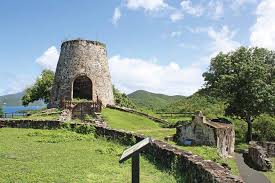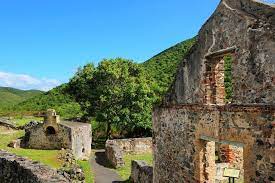The History of Sugarcane in St. John, USVI
St. John, one of the stunning islands in the U.S. Virgin Islands (USVI) archipelago, has a rich history intertwined with the cultivation of sugarcane. Sugarcane played a pivotal role in shaping the island’s economy, society, and landscape. This article delves into the captivating story of sugarcane in St. John, tracing its origins, its influence on the island’s development, and its eventual decline.
Origins of Sugarcane in St. John
The cultivation of sugarcane in St. John dates back to the 18th century when Danish colonists established plantations on the island. They recognized the island’s fertile soil and favorable climate as ideal for growing sugarcane. Plantation owners brought enslaved Africans to St. John to work on the sugar plantations, creating an enduring legacy of African influence on the island’s culture.

The old windmill at the Annaberg Sugar Plantation
Sugar Industry Boom
During the 19th century, St. John experienced a significant boom in the sugar industry. Several large-scale plantations emerged, including Annaberg, Caneel Bay, and Susannaberg, among others. These plantations produced substantial quantities of sugarcane, which were processed into raw sugar or molasses.
The plantations became the epicenter of economic activity on the island, with the majority of the population engaged in sugarcane cultivation and processing. The owners of these plantations amassed considerable wealth, making St. John one of the wealthiest islands in the Caribbean during that time.
Challenges and Decline
The prosperity of the sugar industry in St. John faced numerous challenges throughout the 19th century. The introduction of beet sugar in Europe reduced the demand for Caribbean cane sugar. Additionally, hurricanes, droughts, and pests posed significant threats to sugarcane crops, leading to periodic declines in production.
The abolition of slavery in 1848 also had a profound impact on the sugar industry in St. John. The emancipated enslaved population, seeking better opportunities and independence, gradually moved away from plantation work. This resulted in labor shortages and further hindered the industry’s viability.
By the late 19th century, many sugar plantations in St. John were abandoned or converted to other agricultural activities. The rise of tourism in the 20th century shifted the focus of the island’s economy, drawing attention away from the declining sugar industry.
Preservation Efforts
Despite the decline of the sugar industry, remnants of St. John’s sugarcane heritage can still be found on the island. The Virgin Islands National Park, established in 1956, encompasses several former plantation sites, including Annaberg and Caneel Bay. These sites have been preserved as historical landmarks, providing visitors with a glimpse into St. John’s past.
Today, visitors to St. John can explore the ruins of sugar mills, distilleries, and other structures associated with sugarcane production. These sites offer insights into the island’s history, the lives of enslaved Africans, and the processes involved in sugar production.

Take a walking tour through the Annaberg ruins
In conclusion, the history of sugarcane in St. John, USVI, is a fascinating tale of prosperity, challenges, and transformation. From its origins in Danish colonial plantations to its decline in the face of changing economic dynamics, the sugar industry left an indelible mark on the island. While the cultivation of sugarcane is no longer a dominant force, the preservation of historical sites ensures that the legacy of this once-vibrant industry endures, allowing locals and visitors alike to appreciate and learn from the past.
